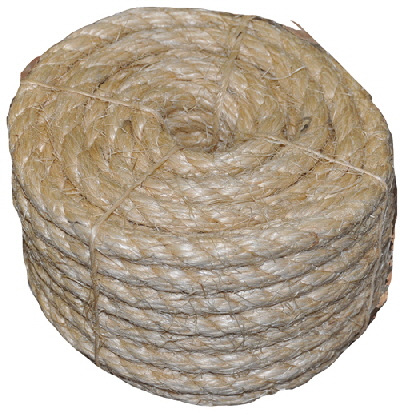While I was looking into buying some new running rigging for Britannia I started to consider some of the newer ropes that are now available. Some of these, like Dyneema® can carry unbelievable loads that conjure up absurd scenarios. Britannia weighs about 44,000 lbs., so theoretically a single length of 5/8” inch 12 strand Dyneema, about as thick as a finger, like New England Ropes 5/8” HTS-78, rated at 58,000 lbs., could lift the whole boat! I'm not thinking of putting this to the test, but it serves to illustrate the advancement of modern ropes.
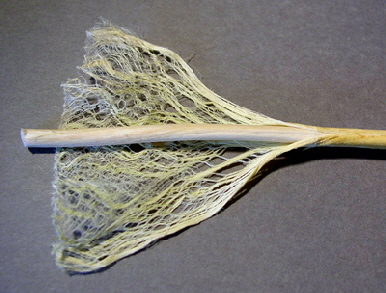 Yet rope is one of the oldest of human tools, used long before recorded history.
Yet rope is one of the oldest of human tools, used long before recorded history.
Drawings in Egyptian tombs from 6,000 years ago show rope, that would have undoubtedly been used to haul the massive blocks that went into building every pyramid. But evidence of rope goes back a lot further than the Egyptians. Fossil fragments have been found in caves carbon dated from 17,000 years ago. If you speared a large deer that then needed two men to lug it back to your cave, you might tie its legs to a strong tree limb and carry it between you. “Tie” being the operative word, probably with some tree creeper or fibrous grass. Individually this might not be strong enough, but simply winding strands together would make it stronger and you would have a rope. Originally this was exactly how ropes were made, by intertwining various plant fibers. The Chinese were the first to perfect the superior Hemp fibers to make rope around 2800 BC.
 Hemp is a rapidly growing fibrous plant, a species of the Abacá banana family but not to be confused with its marijuana cousin. The long stem is flayed to remove fibrous membranes that are then dried and woven into rope.
Hemp is a rapidly growing fibrous plant, a species of the Abacá banana family but not to be confused with its marijuana cousin. The long stem is flayed to remove fibrous membranes that are then dried and woven into rope.
Manila rope is also made of Hemp, but so named because Manila, in the Philippines, was a major growing, manufacturing and shipping port. Ropes were also made from Coir fiber from the outer fibers of coconuts because it is waterproof and one of the few natural fibers resistant to saltwater. Sisal rope is also a plant fiber from the Agave plant, that has long leaves from which the fibers are extracted
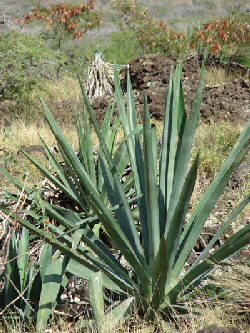
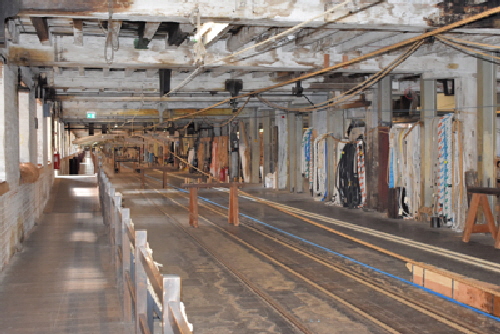 The actual construction of rope hardly changed over these millennium and even as late as the 18th century the same base fibers were still being laid-up along ‘rope walks.’ These were often just long open lanes but that might also have a covered roof. Individual thin fibers were staggered then intertwined. Multiple fibers were twisted into yarns then yarns were intertwined in the opposite direction to form strands. Traditionally three strands were then wound the opposite way to form “Hawser laid rope.” This process is called counter twisting and prevents the rope unwinding. For heavier duty rope, like anchor cable, three of more hawser laid ropes would be intertwined to form “cable laid.” Historic Chatham Dockyard in Kent, England, where many famous ships of war were made including HMS Victory, still has a working rope walk. It is 1135’ feet (346 m) long and it used to take a 200 man workforce to make a 1000 foot anchor cable, all by hand.
The actual construction of rope hardly changed over these millennium and even as late as the 18th century the same base fibers were still being laid-up along ‘rope walks.’ These were often just long open lanes but that might also have a covered roof. Individual thin fibers were staggered then intertwined. Multiple fibers were twisted into yarns then yarns were intertwined in the opposite direction to form strands. Traditionally three strands were then wound the opposite way to form “Hawser laid rope.” This process is called counter twisting and prevents the rope unwinding. For heavier duty rope, like anchor cable, three of more hawser laid ropes would be intertwined to form “cable laid.” Historic Chatham Dockyard in Kent, England, where many famous ships of war were made including HMS Victory, still has a working rope walk. It is 1135’ feet (346 m) long and it used to take a 200 man workforce to make a 1000 foot anchor cable, all by hand.
The strength of these ropes was always very much dependent upon the closeness of the intertwined organic fibers. But on February 28, 1935 everything about rope changed. On that day a chemist named W. H Carothers working at DuPont's research facility at Wilmington, Delaware perfected a synthetic fiber they called Nylon. Not only were the individual yarns stronger and lighter than anything previously available but they could be produced continuously, so there was no need to overlap them to make rope. Consequently, any length could be made, and the rope walk suddenly became redundant.
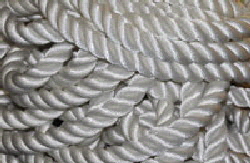 However marvelous Nylon was for other uses, conspicuously for women’s stockings, it had limitations on boats. Even though it was stronger than any other rope at the time it also stretched under load and absorbed water, causing it to become heavier and some ten to fifteen percent weaker. Sailing vessels do not generally need stretchy rope, except maybe for mooring lines, where some give is desirable.
However marvelous Nylon was for other uses, conspicuously for women’s stockings, it had limitations on boats. Even though it was stronger than any other rope at the time it also stretched under load and absorbed water, causing it to become heavier and some ten to fifteen percent weaker. Sailing vessels do not generally need stretchy rope, except maybe for mooring lines, where some give is desirable.
Some sailors refer to their running rigging as rope, but the correct term is line. Whilst they are both physically the same, a rope becomes a line when it is designated for a specific purpose on a vessel. A halyard is a line, (made of rope), but an unused coil on deck is rope.
 The advent of polyester braided rope overcome the deficiencies of Nylon and because of the way it is constructed it produced stronger rope. Instead of twisting three strands together eight thinner strands are interwoven or plaited together to form an outer cover. Inside this is a core, that is also plaited. Each is actually a separate rope but they work in tandem when a load is applied. This type of construction is generically called braided rope and is immensely strong for its thickness, enabling much thinner lines to be used than old hawser laid. This in turn reduces windage and weight overall on a boat. This rope is also easier on the hands than the old coarse materials and also very flexible, passing easily through and around blocks. It hardly stretches at all and is made in many different colors that helps with identification on a rope-strewn deck or cockpit.
The advent of polyester braided rope overcome the deficiencies of Nylon and because of the way it is constructed it produced stronger rope. Instead of twisting three strands together eight thinner strands are interwoven or plaited together to form an outer cover. Inside this is a core, that is also plaited. Each is actually a separate rope but they work in tandem when a load is applied. This type of construction is generically called braided rope and is immensely strong for its thickness, enabling much thinner lines to be used than old hawser laid. This in turn reduces windage and weight overall on a boat. This rope is also easier on the hands than the old coarse materials and also very flexible, passing easily through and around blocks. It hardly stretches at all and is made in many different colors that helps with identification on a rope-strewn deck or cockpit.
There are basically three types of braided rope, that are made using various materials, like Polyester, Polyethylene, etc.
- Hollow braided rope is created by plaiting groups of fibers together to create a tight tube with a hollow center.
- Solid braid has a solid inner core, giving it more strength than a hollow braided rope, but less flexible.
- Double braid has a braided outer cover and an inner core and by far the strongest of the three.
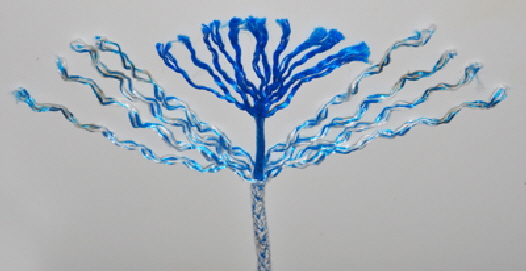 Comparatively recently, over the past 30 years or so, another material has been developed. This is quite a mouthful to name and with an acronym just as awkward. It is called “Ultra High Molecular Weight Polyethylene Fiber,” (UHMWPF). It was developed by a Dutch company and is reputed to be the strongest and lightest rope in the world. They called it Dyneema® and it is now made into rope for boats by all the leading manufacturers. So what makes Dyneema so special for our boats?
Comparatively recently, over the past 30 years or so, another material has been developed. This is quite a mouthful to name and with an acronym just as awkward. It is called “Ultra High Molecular Weight Polyethylene Fiber,” (UHMWPF). It was developed by a Dutch company and is reputed to be the strongest and lightest rope in the world. They called it Dyneema® and it is now made into rope for boats by all the leading manufacturers. So what makes Dyneema so special for our boats?
Weight for weight Dyneema rope is said to be fifteen times stronger than 7x19 stainless steel wire! Size for size it is reputed to be eight times lighter! This presents the remarkable possibility of using rope in place of wire for standing rigging, offering a significant weight reduction where it is most important on a sailboat, high up in the rigging.
Other advantages are:
- Dyneema rope does not absorb water and remains the same weight when wet. It also does not go rusty like steel
- Dyneema has a specific gravity of 0.97 which means it floats. This would be an advantage if a Dyneema line went overboard under power, since it would not sink and fowl the prop’ like a heavier line surely would.
- It has very good resistance to sunlight, an important consideration for cruising sailboats.
- Dyneema rope is not such a “tight” weave as double braided line and the method of splicing an eye is considerably easier than braided rope.
These are significant benefits for Dyneema on sailboats. But as one might expect there is a disadvantage as well. From a scan of the major discount outlets on the web, Dyneema rope is between three to four times the price of double braided of the same thickness. This might explain why there are not so many cruising sailboats around with Dyneema lines or rigging. I made a quick back of an envelope estimate that it would cost about $2,400 to just change the running rigging on Britannia, not even including the standing rigging. But that would be infinitesimal compared to the cost of re-rigging an older more famous Britannia. The 100 gun first-rate ship of the line that fought at Trafalgar in 1805 had 43 miles of Hemp line weighing 79 tons. Imagine the weight saving and reduced windage if they could have used Dyneema!
![]()
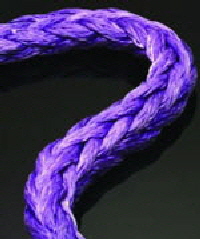 Indeed, rope making has come a long way in the past 100 years and Manufacturers continue to combine the benefits of modern fibers to produce different ropes for various marine uses. The New England Rope Company even make a three strand polyester hawser laid rope in the traditional brown Hemp color. They call it Vintage 3 strand®, and it looks just like the real thing. The big difference is: ½” inch Vintage 3 strand is rated at 6,200 lbs., whereas the same size in Manila will only carry about 2,000 lbs.
Indeed, rope making has come a long way in the past 100 years and Manufacturers continue to combine the benefits of modern fibers to produce different ropes for various marine uses. The New England Rope Company even make a three strand polyester hawser laid rope in the traditional brown Hemp color. They call it Vintage 3 strand®, and it looks just like the real thing. The big difference is: ½” inch Vintage 3 strand is rated at 6,200 lbs., whereas the same size in Manila will only carry about 2,000 lbs.
Spectra® is another comparatively new synthetic fiber from Honeywell industries that is reputed to be even stronger than Dyneema. It is formed into 12 strand rope by Puget Sound Ropes, that they call Plasma®. Pelican Ropes also offer a Spectra 12 strand rope, that they call Synthetic Stainless Rope®, suggesting it as a specific substitute for stainless wire standing rigging.
When considering the strengths of these ropes it is worthwhile to remain mindful of their purpose, if only for the sake of your bank balance. The strongest rope may not always be the best to use for some lines on a sailboat. A very strong williwaw once hit my boat unexpectedly in the bay of Gibralter and wrenched the clew out of my expensive multi-colored Genoa, and it would have been much cheaper if the sheet had snapped instead. Three strand Nylon, or even Manilla, is still perfectly satisfactory to use as mooring lines and available wherever there are boats, and also cheap to replace. Horses for courses.
